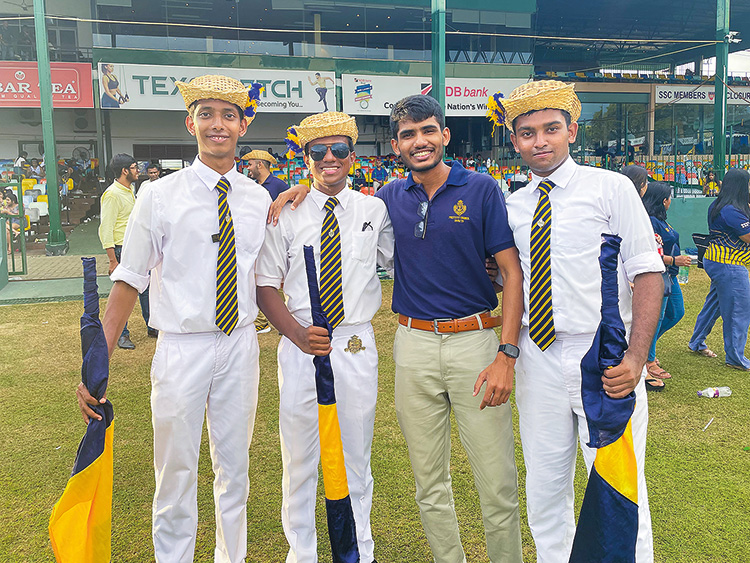Features
Anatomy of a Match: The Royal Thomian Up Close (Part II)

By Uditha Devapriya and Uthpala Wijesuriya
“It’s almost like a ritual, with its codes and ceremonies.”
Nimsara Thennakoon, Former Royal College Prefect
(Continued from last week)
The venue of the Royal Thomian has itself become an attraction. The inaugural encounter unfolded at Galle Face Green. From there, it shifted to the Nomads Cricket Club in Victoria Park, the Colombo Oval, the Nondescript Cricket Club, and the Singhalese Sports Club (SSC). These were, and remain, the most lucrative sports clubs in the country: the SSC, for instance, recently celebrated its 125th anniversary.
Yet, despite these charges of elitism, the Royal Thomian has readily absorbed several popular, non-elite cultural elements. These include the music.
In the early 20th century, one invariably heard only English songs: one old Royalist recalls that “Sinhala and Tamil were unheard of.” Today, by contrast, English songs have become something of an exception.
A typical Royal Thomian playlist would consist of Sinhala baila. Its characteristic six/eight beat puts wings on everyone’s feet: “It’s hard not to dance when you hear it,” one spectator puts it. A thoroughly hybridised art form – with a long and rich history – it has now become a must-include item at every function, from parties to weddings to corporate events. At the match, it occupies a pivotal place, following a rather predictable pattern.
To be sure, baila may not be to everyone’s liking. The uninitiated can find it too loud and too vulgar, too “masscult” or lowbrow for their tastes. But with time, it has transformed the Royal Thomian, along with its social composition.
One spectator put it rather heartily: “Who the hell listens to symphonies here?”
A Rite of Passage
Perhaps more than anything, the Royal Thomian provides an opportunity for Old Boys to relive and “reclaim” their childhoods. For students, it serves almost as a rite of passage: a grand spectacle against which they grow into adults while still retaining the joi de vivre of their schooldays. To be a schoolboy, in this scheme of things, is to break every rule in the book. That can be rather disconcerting for first timers: at the Boys’ Tent, for instance, not even teachers can forbid students from spitting out the obscenities without which no Royal Thomian, or baila session for that matter, would be complete.
Pulindu, a student who did his final exams this year, recalls his experience only too well.
“At first I wondered why teachers were okay with us singing these songs. It was like breaking a sacred vow. The more I sang, the more I felt like a part of it all.”
At the Boys’ Tent last year, Pulindu found himself playing a different role, as a Steward: instead of singing these verses, he had to get others to sing.
“The highlight was when the Principal entered the Tent. Even he was taken up by us. He just joined in and started talking and joking with us.”
In other words, age becomes just a number. Students defy adults, and adults, for their part, encourage their behaviour. It’s not unusual to see the youngest and the oldest of students and Old Boys sharing a beer and a smoke with each other, complete strangers though they may be. No less unusual is the sight of fathers encouraging their sons to indulge in the most outlandish pursuits. One not-so Old Thomian captures this well: “The Royal Thomian is primarily about boys – including those disguised as older and wiser men.” Perhaps this is why many Old Boys, even former prefects, tend to wear shorts at the match.
The tents serve a similar function here. Apart from the Mustangs, the Royal Thomian hosts several other tents, each belonging to a particular batch and generation. “The idea,” a member of Stables – put up by the S. Thomas’ “Class of 1979” – argues, “is for students to move from one generation to the next, from childhood to adulthood.”
Unlike in a rite of passage, however, the student does not “lose” his childhood as he moves from one tent to another: he reclaims it, and relives it.
Of course, this is not to say that the Royal Thomian is anarchic, or that it disregards every rule in the book. There are strict demarcations of roles and responsibilities, particularly within the student body: Stewards oversee the students at the Boys’ Tent, while Prefects – the only people, outside the players, the security personnel, and the Organising Committee allowed into the stadium while the match is going on – patrol the area.
Donning sunglasses and straw hats, with a stern demeanour that occasionally dissolves into smiles and laughs, they represent an ideal to aspire to for the boys: at both schools, becoming a Prefect is the highest honour a student can receive.
The Royal Thomian is the first event of the year where Prefects officiate. As far as the match goes, they are the highest authority figures: teachers have little sway here.
Teachers also have little sway over the events that lead to the Royal Thomian. These include a cycle parade and an “unofficial” vehicle parade. Arguably the most notorious of them all is “trucking” – the practice of jumping into nearby girls’ schools.
These events – “traditions”, as students prefer to call them – have exhaustive histories: records indicate that trucking, for instance, took place in the 1930s and 1940s, even earlier. Though they may have served a different function then, these practices unfold in a fairly concrete form today. In recent years, however, concerns over vandalization have compelled authorities to take action against would-be truckers.
The most typical response one gets when questioning or criticising these customs is that they have taken place for a long time and will take place no matter what. In the eyes of students and Old Boys, they have acquired the status of a ritual. Come what may, they must be performed. And somehow or the other, they are.
This curious blend of anarchy and authority is perhaps what best epitomises the Royal Thomian. One notices a reversal of roles throughout the event, with men behaving like boys and boys – especially Prefects and, to a lesser extent, Stewards – becoming adults. Such inversions are typical, and are an integral part of the fun.
In the context of South Asian cricket, the Royal Thomian has yet to be surpassed. At one level, this may be because schools in other South Asian countries don’t command the kind of loyalty or devotion which schools in Sri Lanka – elite or otherwise – do.
In the wider world of Sri Lankan cricket, of course, things have changed. Until recently, the top cricket players used to hail from these schools. Today, rather inevitably, the Royal Thomian hold over the game has faded. Yet at these schools, becoming part of the First XI squad is as much an honour as playing for the National Team.
Whatever one may think of the Royal Thomian – and it has its champions and detractors – there is certainly no denying this sense of fraternity. For Nimsara Thenakoon, who passed out as a student, Steward, and last year a Senior Prefect, it holds everyone together, like a clan, with its codes, ceremonies, and rites: “The Prefects take the lead, the Stewards serve as their assistants, and everyone else follows them.”
An Old Boy agrees: “The Royal Thomian is family – and ironically, sometimes much more than the dysfunctional social groups we grew up in.”
Such sentiments appear parochial at first glance. But students and Old Boys swear by them, claiming – with justifiable pride – that no other match can top this one.
In the final reckoning, then, the Royal Thomian is a cricket match that exists beyond the cricket, an elite encounter that somehow manages to include everyone.
Perhaps, at the end of the day, that is what a cricket match ought to be.
Uditha Devapriya is an international relations analyst, researcher, and freelance columnist who can be reached at udakdev1@gmail.com.
Uthpala Wijesuriya is a law and international relations student and history researcher who can be reached at wijesuriyau6@gmail.com.
Uditha and Uthpala are the two leads of U & U, an informal Sri Lankan collective that engages in art and culture research. Twitter handle: @uanduthoughts.
Features
‘Silent Majority’ abandoned to Long-suffering in regional conflicts

 With reports emerging that India has attacked some ‘sites’ in Pakistan and Pakistan-administered Kashmir, the question could be posed whether the stage has just been set for yet another costly India-Pakistan military conflict. Sensible opinion in South Asia could only hope that wise counsel would sooner rather than later come to prevail on both sides of the divide and that they would draw back from the brink of full-scale war.
With reports emerging that India has attacked some ‘sites’ in Pakistan and Pakistan-administered Kashmir, the question could be posed whether the stage has just been set for yet another costly India-Pakistan military conflict. Sensible opinion in South Asia could only hope that wise counsel would sooner rather than later come to prevail on both sides of the divide and that they would draw back from the brink of full-scale war.
The states concerned ought to know fully well the possible wide-ranging weighty consequences of another regional conflict. It should be plain to see that it would benefit none in the two theatres of confrontation, most particularly the relevant publics or the ‘Silent Majority’.
In fact, in connection with the mentioned initial military attacks, the Pakistani side has gone on record that some civilian lives have been lost. Such losses could burgeon in the event of full scale hostilities. These costs could of course be staggering and unimaginable in the event the nuclear option is resorted to by the sides, going forward.
Accordingly, the hope of the peace-loving world-wide is likely to be that India and Pakistan would give negotiations a chance and resolve their differences peacefully. It would be in the best interests of the world for the champions of peace to join their voices to that of UN chief Antonio Guterres and call on the sides to negotiate an end to their differences.
The utter helplessness and misery of the people of the Gaza ought to drive home afresh the horrors of war. Currently the news is that the Gazans are literally starving to death. Food and other essentials provided by UN agencies are reportedly being prevented by Israel from getting to the hapless people of Gaza. So dire is their situation that concerned quarters are calling on the compassionate worldwide to provide the Gazans with food, water and other essentials voluntarily. This SOS would need to be heeded forthwith.
Accordingly, it could be inferred that most formal arrangements, including those that are generally under the purview of the UN, geared to providing emergency humanitarian assistance to the needy, have, for all intents and purposes, been rendered ineffective in the Gaza. The UN cannot be faulted for this state of things; rather, Israel should be held accountable in the main for it.
The matter of accountability is central to the dramatic slide into lawlessness the world has been experiencing over the past few decades. As could be seen, International Law is no longer fully applicable in the conflict and war zones of the world because it is not being adhered to by many state and non-state aggressors. That the UN is hapless in the face of such lawlessness is plain to see.
We have of course the Middle East wherein International Law has fallen silent for quite a while. How could it be otherwise, when Israeli aggressions are being winked at by the US, for which the policy of backing Israel is almost sacrosanct?
Moreover, under President Donald Trump, it is difficult to see the US changing policy course on the Middle East. Trump made vague promises of bringing peace to the region in the run-up to his reelection but has done nothing concrete by way of peace-making. Consequently, complete lawlessness prevails in the Middle East. US policy towards Israel counts as another example of how the self- interest of US central administrations blinds them to their international obligations, in this case Middle East peace.
However, the commentator could be criticized as being biased if he holds only Israel responsible for what has befallen the Middle East. It has been the position of this columnist that Israel’s security needs should be taken cognizance of by its state and non-state adversaries in the Middle East and acted upon if the basis is to be laid for a durable Middle East peace. Inasmuch as Palestinian statehood must be guaranteed, the same should be seen as applicable to Israel. The latter too enjoys the right to live in a secure state of its own, unopposed by its neighbours.
The Ukraine of today is also sad testimony to the ill consequences of powerful, aggressor states wantonly disregarding International Law and its obligations. Nothing could justify Russia in invading Ukraine and subjecting it to a condition of Longsuffering. Clearly, Ukraine’s sovereignty has been violated and such excesses go to the heart of the current state of ‘International Disorder’. Of course the same stricture applies to the US in relation to its military misadventures in Afghanistan and Iraq, to name just two such modern examples.
There is no ducking the fact, then, that civilian publics in the mentioned theatres of war and outside, are being subjected to the worst suffering as a consequence of the big powers’ self-aggrandizement schemes and military misadventures. Longsuffering becomes the tragic lot of the people who have nothing to do with such unbridled power ambitions.
One would not be exaggerating the case if he states that civilian publics count for almost nothing in the present ‘International Disorder’. Increasingly it is becoming evident that from the viewpoint of the big powers and authoritarian governments the people are of little or no importance. Considering that self-aggrandizement is of the paramount interest for the former the public interest is coming to be seen as inconsequential.
Consequently, not much of a case could be made currently for the once almost reverentially spoken of ‘Social Contract’. For, the public interest does not count for much in the scrambles for power among the major powers who are seen at the popular level as the principal history-makers.
It is in view of the above that much is expected of India. Today the latter is a ‘Swing State’ of the first importance. Besides being a major democracy, it is one of the world’s principal economic and military powers. It possesses abundant potential to help to put things right in international politics. If there is one state in Asia that could help in restoring respect for International Law, it is India.
Considering the above, India, one believes, is obliged to bear the responsibility of keeping South Asia free of any more long-running, wasting wars that could aggravate the material hardships and socio-economic blights of the region. Thus, India would need to consider it imperative to negotiating peace with Pakistan.
Features
Memorable happening … Down Under

 Under the Global-Ise Australia Advanced Sports Development Programme, a delegation of 15 swimmers from Lyceum International School, Wattala, had the remarkable opportunity to train and experience high-performance sports development in Melbourne, Australia.
Under the Global-Ise Australia Advanced Sports Development Programme, a delegation of 15 swimmers from Lyceum International School, Wattala, had the remarkable opportunity to train and experience high-performance sports development in Melbourne, Australia.
The 10-day programme was carefully curated to offer intensive training, educational exposure, and cultural experiences for the young athletes.
The swimmers underwent specialised training through Swimming Victoria’s elite programme, held at some of Melbourne’s premier aquatic facilities.

Visit to Victorian Parliament
Each day began as early as 5:00 a.m. and continued until 7:00 p.m., ensuring a rigorous and enriching schedule that mirrored the standards of international competitive swimming.
Beyond training, the programme offered a wide array of experiences to broaden the students’ horizons.

Morning training
The tour group explored iconic landmarks such as the Victorian Parliament and the Melbourne Cricket Ground (MCG), and enjoyed shopping at Chadstone – The Fashion Capital. They also experienced the natural beauty of Victoria with visits to Yarra Valley Chocolaterie & Ice Creamery, and Cardinia Reservoir Park, where they observed kangaroos in their natural habitat.
An academic highlight of the tour was the group’s exclusive visits to three of Australia’s leading universities: the University of Melbourne, Monash University, and Deakin University. These visits aimed to inspire students and showcase the vast educational opportunities available in Australia.

Checking out the scene at Yarra Valley Chocolaterie & Ice Creamery
As part of the cultural immersion, Global-Ise hosted a traditional Australian BBQ at the Tim Neville Arboretum in Ferntree Gully. The students also enjoyed a variety of diverse culinary experiences each evening, further enriching their understanding of local and international food cultures.
The tour concluded with a celebratory dinner at the Spicy Wicket Restaurant, where each participant received a presentation in recognition of their involvement.

Enjoying an Aussie BBQ for lunch
The evening was made especially memorable by the presence of Pradeepa Saram, Consul General of Sri Lanka in Victoria.
Global-Ise Management—Ken Jacobs, Johann Jayasinha, and Dr Luckmika Perera (Consultant from the University of Melbourne)—did a magnificent job in planning and the execution of the advanced sports programme.

Coaches from Sri Lanka presenting a plaque to Global-Ise Management team
Ken Jacobs (centre), Johann Jayasinha, and Dr Luckmika Perera (on the right
Features
Bright, Smooth Skin

 Hi! How’s the beauty scene keeping with you?
Hi! How’s the beauty scene keeping with you?
Phew, this heat is awful but there is nothing that we can do about it.
However, there are ways and means to take care of your skin and I will do my best to help you in every way I can.
Well, this week, let’s go for a Bright, Smooth Skin.
Gram flour (also known as besan) is a traditional skincare ingredient known for its:
* Natural exfoliating properties.
* Ability to absorb excess oil.
* Gentle brightening and tan-removal effects.
* Suitability for all skin types, especially oily and acne-prone skin.
You will need 01–02 tablespoons gram flour (besan) and rose water, or raw milk, to make a paste.
You could add the following two as optional add-ins: A pinch of turmeric (for extra glow), and a few drops of lemon juice (for oily skin and pigmentation)
Add the gram flour to a small bowl and mix in the rose water (for oily/sensitive skin) or raw milk (for dry skin) slowly.
Stir well to make a smooth, spreadable paste—not too thick, not too runny.
Now apply this mixture, evenly, to your damp face and neck, and let it sit for 5–10 minutes (don’t let it dry completely if you have dry skin).
Gently massage in circular motions using wet fingers—this helps exfoliate.
Rinse off with lukewarm water, and then pat your skin dry.
Use it 02–03 times a week for best results.
Skin Benefits:
* Removes dirt, sweat, and oil without stripping natural moisture.
* Gently exfoliates dead skin cells, revealing smoother skin.
* Brightens the complexion and fades mild tanning.
* Helps clear clogged pores and reduce pimples.
* Leaves skin fresh and glowing—perfect for humid climates.
-

 News6 days ago
News6 days agoRanil’s Chief Security Officer transferred to KKS
-

 Opinion4 days ago
Opinion4 days agoRemembering Dr. Samuel Mathew: A Heart that Healed Countless Lives
-

 Business2 days ago
Business2 days agoAitken Spence Travels continues its leadership as the only Travelife-Certified DMC in Sri Lanka
-

 Business2 days ago
Business2 days agoLinearSix and InsureMO® expand partnership
-

 Latest News1 day ago
Latest News1 day agoNPP win Maharagama Urban Council
-

 Business6 days ago
Business6 days agoCCPI in April 2025 signals a further easing of deflationary conditions
-

 Features6 days ago
Features6 days agoExpensive to die; worship fervour eclipses piety
-

 Features4 days ago
Features4 days agoTrump’s economic missiles are boomeranging














